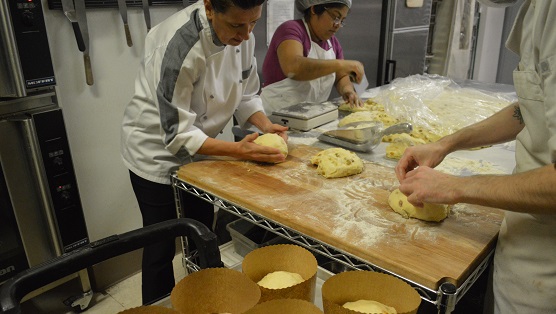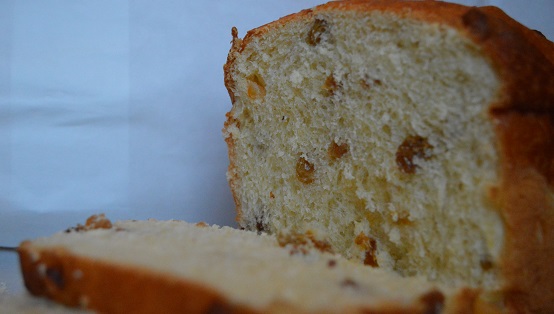This Seattle Bakery Makes Panettone the Old-World Way
Five rises, no dark raisins, and a lot of love go into the making of Gelatiamo's seasonal panettone.
Photos by Jackie Varriano Food FeaturesMaria Coassin used to wake to the sounds of bakers pounding dough, her childhood bedroom situated just above her family’s 200-year-old bakery, Panificio Coassin in Maniago, Italy. Now, and every December, she’s the one mixing, weighing, rolling and baking the dough that becomes her panettone—although she’s no longer in that tiny village in Italy’s northeastern corner, she’s in downtown Seattle.
Just a block away from bustling Pike Street Market sits Gelatiamo, Coassin’s gleaming gelato shop with its cases full of rich gelato, crunchy biscotti and eye-popping cakes and cookies. Items are served the Italian way; you’re meant to order and find a table. Gelato arrives in gleaming steel bowls, espresso in a proper cup and cookies on plates, inviting you to linger over treats and good conversation.
A few dozen steps down an almost hidden staircase takes you to the bowels of the building and Coassin’s kitchen, bustling with worker bees mixing gelato, baking macaroons, boxing up wholesale orders and—most importantly this time of year—watching what Coassin calls her “babies.”
She pats the two tubs of dough affectionately. “Yes, these are my children,” she says with a smile. Straining against the lids is wet, sticky dough that’s on its third rise out of five, one batch of dozens that will create roughly 100 of the 1,200 loaves of panettone that Coassin will bake between Thanksgiving and the New Year.
Like fruitcake, panettone is one of those baked goods that arrives each holiday season, often for sale in grocery stores and retail shops like Cost Plus World Market and TJ Maxx and packed in boxes with a picture of what looks like a fruit-studded loaf. Italian fruitcake, right?
“To compare panettone to fruitcake would be a big mistake,” says Coassin. Her eyes light up as she begins to tell the tale of the holiday bread.
“It comes from Milan, and that’s the only thing Italy agrees upon.”
When it comes to the origin of panettone there are many legends, but the one Coassin prefers is where a poor young baker’s apprentice named Toni wanted to impress a nobleman’s daughter, so he baked this fanciful loaf filled with dried fruit and citrus to impress the nobleman and hopefully win his daughter’s hand.
The bread was so rich and delicious, it won them over and the bread became known as pan del toni, or “bread of Toni” and eventually shortened to what we know now as panettone and eaten all over the world.
Panettone has always been a part of Coassin’s life; the recipe she uses is the same one created in her family’s bakery, taught to her by her father Silvio nearly 20 years ago when she first opened Gelatiamo in 1996.
Gelato had not yet won the hearts of Americans in the mid-90s, and Coassin talks about the issues she had when she opened; “people didn’t know what gelato was, they thought it was gelatin or cream cheese.”
When the weather turned gray and cold she realized there was no way she was going to make it to the next summer as a business selling just gelato in rainy, dreary Seattle. Her father booked a flight, landed in the city with just one small bag and came directly to Gelatiamo. He went to the washroom, cleaned his face, changed his clothes and got to work teaching Coassin how to make panettone, starting the tradition that has carried on to today.
Over the years Coassin has kept painstakingly detailed notes on the batches, even going as far as to keep slivers of years old panettone in her freezer to test how they hold up over time. Each summer she drags out the lists and looks over them, refreshing her mind for what worked—and more importantly—what didn’t. She bakes a sample batch using the final recipe from the previous year, and begins thinking about the upcoming panettone season, deciding what she’ll need to change and what will stay the same.
Like fruitcake, making panettone is a longer process than one might think. But instead of baking an incredibly dense loaf that one bastes lovingly with brandy each day for months, Coassin’s panettone is created from dough to loaf in 27 hours.
The dough begins with high-gluten flour and different ingredients are added during each of the five rises—more flour, dried milk, egg yolks, butter, plumped raisins, lemon oil, lemon peel, orange peel, honey and the tiniest bit of rum.
She’s changed small things about the recipe over the years, tweaking it to work with Seattle’s weather, adjusting baking times depending on the temperature and most recently, switching to all golden raisins.
After the last addition is made and the dough rises once more, it gets portioned and weighed before being rolled lightly into the balls that get set into paper forms, imported from Italy.
Coassin’s hands work quickly to shape the dough, picking out any raisins that have landed on top to keep them from burning.
“You want to work quickly so you don’t raise the temperature of the dough,” she says, as she sprinkles flour on her work surface. She has developed asthma over the past few years, and dealing with this much flour while mixing the dough is troubling, so she has entrusted two of her employees to help mix, making the dough two to three times per week.
However, she has yet to relinquish the final baking process. This means she keeps some pretty long hours during those weeks between Thanksgiving and Christmas, sometimes even snoozing in her tiny office to get the baking times just right.
“It’s all worth it though, and every time I feel tired I just think about my ticket,” she says.
Her ticket is the one she gets to Italy for her annual post-Christmas trip to visit her family, her prize for making it through another crazy panettone season. Her father Silvio has since passed away, but her brothers run the family bakery in Maniago.
The end of the batch has yielded a small, underweight dough ball, which Coassin rolls into a tighter ball.
“This one, I will have for my breakfast,” she says, before nestling it between the forms and tucking it into a covered speed rack with a note that says “Me First” on it.
“I always forget which rack to bake first.”
The finished panettone is light, fluffy bread that climbs a few inches above the top of the paper form, finishing in a domed top. It’s slightly sweet and studded evenly with the raisins and citrus peel, perfect toasted and slathered with butter.
Coassin is a purist, eating hers plain or with coffee—and says loaves are good for weeks.
A friend of hers told her she had made the panettone into French toast for breakfast, which she scoffed at in the beginning.
“But she sent me a picture and it looked so good I think I might have to try it,” she says, with a laugh.
Jackie Varriano is a freelance writer living in the Pacific Northwest. When she’s not at her computer or in the kitchen, you can usually find her elbowing her way to the front at concerts or holed up in the cookbook section of any used book store. She what she’s up to on Instagram @jackievarriano.



